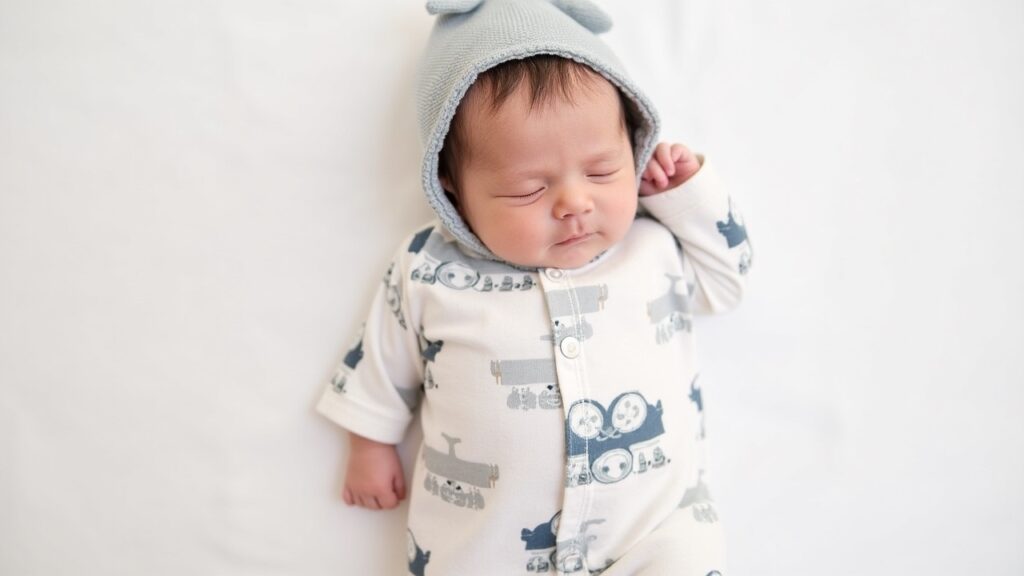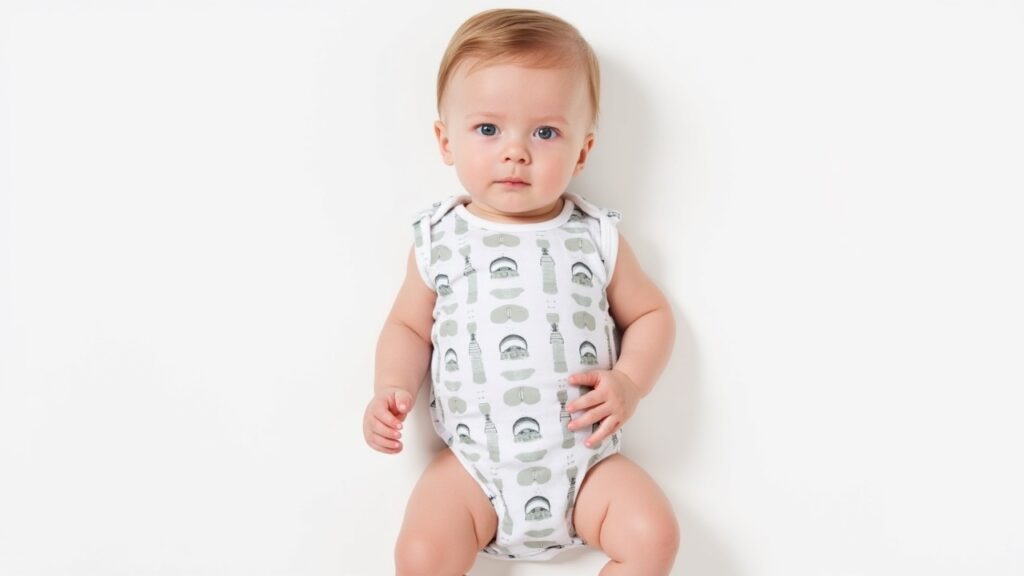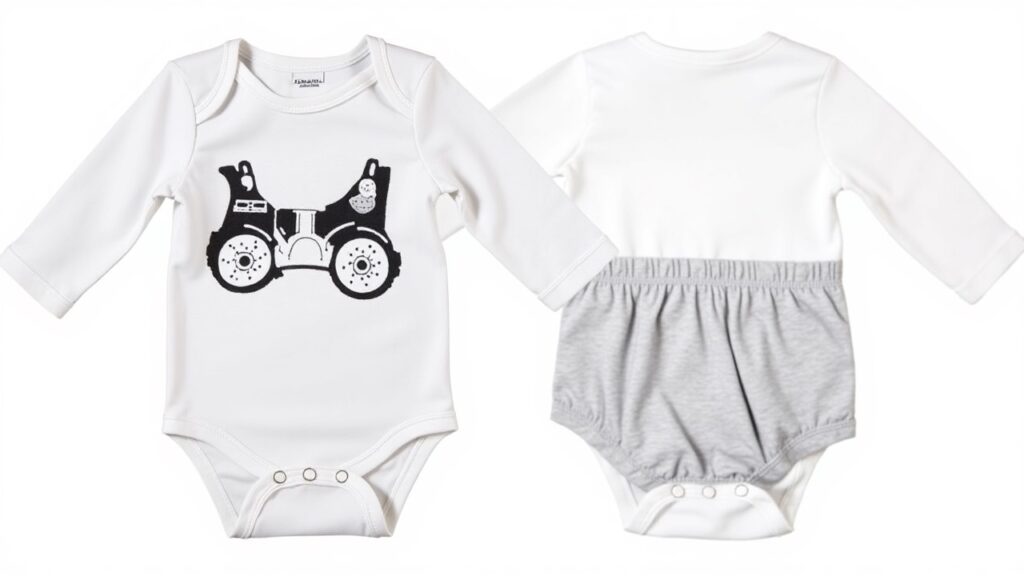Choosing the perfect wardrobe for your newborn baby boy involves balancing style, comfort, and practicality. New mothers often struggle with purchasing clothes that their babies will outgrow within weeks, making smart shopping decisions crucial for both budget and convenience. The rapid growth spurts during the first year mean that traditional sizing approaches simply don’t work for infant clothing.
Quality baby boy outfits combine adorable designs with functional features that accommodate growth spurts and daily wear demands. Adjustable elements, expandable fabrics, and convertible designs help extend the life of each piece significantly. Modern baby fashion has evolved to offer sophisticated options that look stylish while providing the flexibility growing babies need.
Let’s talk about five specific outfit categories that offer both immediate charm and long-term wearability for your little gentleman. These versatile pieces adapt to your baby’s changing size while maintaining their visual appeal throughout different developmental stages.
What Makes Baby Boy Outfits Grow-Friendly

The secret to selecting baby clothes that last lies in understanding which design features accommodate rapid growth. Babies typically gain weight quickly during their first months, making traditional fitted clothing impractical for extended wear. Smart design elements can double or triple the wearing period of each outfit.
Adjustable Features That Extend Wearability
Adjustable straps, expandable waistbands, and snap systems create flexibility in sizing. Look for overalls with multiple snap positions that let you adjust both length and width as your baby grows. Elastic waistbands stretch to accommodate weight gain while maintaining comfort during active play.
Convertible necklines offer another practical advantage. Envelope shoulders on onesies fold down to allow easy removal over messy situations, while also providing room for head circumference growth. These overlapping shoulder seams prevent getting stuck during diaper changes or feeding mishaps.
Fabric Choices for Growing Bodies
Natural fibers like cotton and bamboo provide breathability while offering slight stretch properties. These materials move with your baby’s body during growth spurts without losing their shape. Blended fabrics combining cotton with small percentages of elastane create garments that expand appropriately.
Knit fabrics generally accommodate growth better than woven materials. Jersey knits, interlock, and rib knits all provide the give needed for comfortable movement and size changes. These fabric types also tend to be more forgiving if you accidentally purchase items slightly too small.
Strategic Sizing Approaches
Buying slightly larger sizes works well for certain garment types but not others. Onesies and bodysuits can be purchased one size up without looking oversized, while pants and outerwear need more precise fitting. Consider the garment’s intended function before deciding on sizing strategies.
Layering capabilities also factor into growth-friendly choices. Pieces that work well as base layers continue providing value even after they become snug, while outer layers need room for underlying clothes. This approach maximizes your clothing investment across multiple seasons.
Convertible Rompers and Jumpsuits
One-piece outfits simplify dressing routines while offering excellent growth potential through clever design features. Modern rompers incorporate multiple adjustment points that accommodate changing proportions as babies develop from newborn to toddler stages.
Design Elements That Adapt
Snap-crotch closures in rompers allow for easy diaper access while providing length adjustability. Multiple snap rows let you modify the torso length as your baby grows taller. Some designs include snap-off legs that convert full-length pieces into shorts for summer wear or layering flexibility.
Gathered waistlines with elastic or drawstring adjustments accommodate fluctuating baby weight without looking baggy. These design elements maintain a tailored appearance while providing significant size flexibility. The gathering also creates visual interest that keeps the outfit looking intentional rather than ill-fitting.
Styling Versatility Across Seasons
Choose rompers in neutral colors or classic patterns that work across multiple seasons. Navy stripes, solid gray, or subtle checks maintain their appeal whether worn alone in summer or layered under cardigans in cooler weather. This versatility extends the practical wearing period significantly.
Consider fabric weight variations within the same style. Lightweight cotton versions work for warm weather, while fleece-lined options provide warmth during colder months. Having both weights in similar designs creates a coordinated wardrobe that adapts to seasonal needs.
Comfort Features for Active Babies
Flat seams prevent chafing against sensitive newborn skin while accommodating increased movement as babies become more active. Look for reinforced knees in crawler-style rompers, as these areas experience significant wear once babies start exploring on the floor.
Envelope necklines or zip closures make dressing easier for parents while providing comfort for babies who dislike having clothes pulled over their heads. These features become increasingly important as babies develop preferences and personalities around clothing changes.
Mix-and-Match Separates Systems
Building a wardrobe around coordinating separates creates numerous outfit combinations while accommodating uneven growth patterns. Babies don’t always grow proportionally, making separates more practical than complete outfit sets that may not fit properly across all body areas.
Creating Cohesive Color Palettes
Select pieces within a limited color family to maximize mixing potential. A palette built around navy, white, and gray creates dozens of combinations from just six to eight individual pieces. This approach reduces decision fatigue while providing outfit variety.
Neutral base colors pair well with seasonal accent pieces. Basic onesies in white or cream work under everything, while colored cardigans or vests add personality without requiring complete outfit coordination. This strategy keeps your baby looking put-together with minimal planning effort.
Proportional Flexibility Benefits
Separates accommodate babies who might wear different sizes on top versus bottom. Some infants have longer torsos with shorter legs, while others show the opposite proportions. Individual pieces let you address these variations without compromising fit or comfort.
Here are practical benefits of mix-and-match systems:
Easy Washing: Individual pieces can be replaced quickly when one gets stained or damaged.
Budget Friendly: You can purchase key pieces gradually rather than complete expensive outfit sets.
Growth Adaptation: Replace pieces as needed rather than entire outfits when sizing changes.
Style Evolution: Add trendy accent pieces to refresh classic basics without major wardrobe overhauls.
Investment Piece Strategies
Focus spending on high-quality basics that get frequent wear. Well-made onesies, comfortable pants, and versatile cardigans provide the foundation for countless outfit combinations. These core pieces justify higher prices through extended use and washing durability.
Accent pieces can be purchased more affordably since they’re worn less frequently. Fun printed shirts, seasonal accessories, or special occasion pieces don’t need the same quality investment as daily wear basics. This approach balances style desires with practical budget considerations.
Layering Systems for Year-Round Wear

Thoughtful layering extends the seasonal usefulness of baby clothes while creating visually interesting outfits. Smart layering pieces work across temperature variations and growth spurts, making them particularly valuable for rapidly changing infant needs.
Foundation Layer Essentials
Quality undershirts and onesies form the base of effective layering systems. These pieces should fit snugly without being restrictive, providing warmth and protection while remaining invisible under outer layers. Neutral colors prevent show-through under lighter-colored clothes.
Tank-style onesies work well in warmer weather or heated indoor spaces, while long-sleeve versions provide additional warmth when needed. Having both options in similar colors creates flexibility for temperature changes throughout the day or season.
Middle Layer Versatility
Cardigans, vests, and light sweaters provide adjustable warmth that adapts to changing conditions. Choose pieces with easy-open fronts for quick adjustments as temperatures fluctuate. Button or snap closures work better than pullover styles for active babies who resist clothing changes.
Consider texture variety in your middle layer selections. Smooth cotton pieces layer well under everything, while textured knits add visual interest when worn as outer layers. This variety keeps outfits looking fresh across different occasions and settings.
Outer Layer Adaptations
Lightweight jackets and hooded sweatshirts provide weather protection while maintaining the cute factor parents want. Look for designs that accommodate car seat safety requirements, avoiding thick padding that interferes with proper harness positioning.
Convertible sleeves that roll up or snap off extend the wearing season for outer layers. These features let you adapt pieces for changing weather without purchasing entirely new items. Such versatility particularly benefits families living in areas with variable seasonal temperatures.
Weather-specific considerations include breathable rain protection and wind-resistant fabrics that don’t add excessive bulk. Modern baby outerwear balances protection with mobility, letting your little one stay comfortable during outdoor adventures.
Adjustable Waistband Bottoms

The rapid weight fluctuations common during infancy make adjustable waistbands particularly valuable for maintaining proper fit and comfort. These design features prevent the constant purchasing cycle that fixed-waist pants typically require.
Elastic Waistband Benefits
Soft elastic waistbands move with your baby’s body during active play while accommodating weight changes from growth spurts or temporary fluctuations. Look for wide elastic bands that distribute pressure evenly rather than narrow versions that can dig into sensitive skin.
Adjustable elastic systems with internal drawstrings provide customizable fit without compromising comfort. These features work particularly well for babies transitioning between sizes, extending the wearing period significantly. The adjustability also helps achieve proper fit for babies with different body proportions.
Snap and Button Adjustments
Multiple button positions on waistbands create sizing flexibility similar to adult pants with adjustable features. These systems work well for older infants who need more structured pants for crawling and eventual walking activities.
Side snaps provide another adjustment option while maintaining smooth front appearances. This design prevents bulk around the midsection while offering the flexibility needed for proper fit across different growth stages.
Cuff and Hem Adaptations
Adjustable cuffs extend length as babies grow taller without requiring complete size changes. Snap-up cuffs, fold-over hems, and roll-up designs all provide length flexibility while maintaining proportional appearance.
Consider pants with reinforced knees for crawling protection that doesn’t interfere with washing or comfort. These features become increasingly important as babies develop mobility and spend time exploring floor surfaces.
Growing room in the seat area accommodates diaper bulk while providing space for natural growth. This consideration becomes particularly important for babies using cloth diapers, which require additional room compared to disposable options.
Expandable Necklines and Sleeves
Neckline and sleeve adjustments accommodate the rapid changes in infant proportions while preventing the stuck-clothing situations that frustrate both babies and parents. These features become increasingly important as babies develop preferences about dressing routines.
Envelope Shoulder Designs
Envelope shoulders on shirts and onesies create expandable neck openings that stretch to accommodate head circumference growth. These overlapping shoulder seams also provide emergency removal options when clothes become soiled during diaper mishaps.
The folding design maintains visual appeal while serving practical functions. These shoulders look intentional rather than utilitarian, keeping your baby looking stylish while providing parental convenience during clothing changes.
Snap Shoulder Options
Shoulder snaps eliminate the need to pull clothes over babies’ heads entirely, making dressing routines faster and less stressful. This feature particularly benefits babies who dislike having their vision blocked during clothing changes.
Choose snaps made from durable materials that withstand frequent washing without losing their grip. Quality hardware ensures that these convenient features continue working throughout the garment’s useful life.
Expandable Sleeve Systems
Rollable cuffs extend sleeve length as arms grow longer while maintaining proportional appearance. These features work well for both casual and dressy pieces, providing growth accommodation without sacrificing style.
Snap-adjustable sleeves offer precise length control while creating interesting design details. These elements can serve as decorative features when snapped short or provide full coverage when extended to maximum length.
Consider sleeve designs that work well for layering underneath other pieces. Smooth, fitted sleeves layer better under cardigans and jackets, while looser styles work well as standalone pieces during warmer weather.
Finding the Perfect Balance
Balancing style desires with practical needs creates baby wardrobes that serve both fashion and function effectively. The most successful approach combines immediate visual appeal with long-term wearability features that justify the investment in quality pieces.
Modern baby fashion offers sophisticated options that don’t sacrifice practicality for appearance. Smart shopping strategies focus on pieces that provide multiple benefits while maintaining the adorable factor that makes dressing babies such a joy. Your little one can look stylish while wearing clothes that adapt to his changing needs throughout his rapid growth phases.
The key lies in selecting pieces with built-in flexibility that grows alongside your baby boy. These thoughtful designs prevent the frustration of constantly outgrown clothes while keeping your little gentleman looking perfectly dressed for every occasion.
Frequently Asked Questions
Q: How many outfits should I buy in each size for a newborn baby boy?
A: Purchase 4-6 everyday outfits per size, focusing on basics like onesies and pants that can be mixed and matched rather than complete outfit sets.
Q: What size should I buy for maximum growth potential?
A: Buy most items in your baby’s current size, with a few pieces one size larger for rapid growth periods, particularly for items like sleepers and onesies.
Q: Are expensive baby clothes worth the investment for rapid growth phases?
A: Focus spending on high-quality basics that get daily wear, while choosing more affordable options for trendy pieces or special occasion items worn less frequently.
Q: How do I know when baby clothes are too small?
A: Watch for tight leg openings, difficulty snapping crotch closures, stretched fabric across the chest, or red marks on skin after wearing.
Q: Can I use the same outfit sizing strategy for all baby clothing types?
A: No, different garment types require different approaches – onesies can be bought larger while pants and shoes need more precise fitting for comfort and safety.
Q: What features should I prioritize for crawling babies?
A: Look for reinforced knees, comfortable waistbands that don’t restrict movement, and fabrics that wash easily since floor exploration increases laundry needs.
Q: How do I maintain outfit coordination with mix-and-match pieces?
A: Build around a limited color palette of 3-4 coordinating colors, ensuring all pieces work together rather than purchasing random individual items.
Q: Should I buy seasonal items in larger sizes?
A: Purchase seasonal items like coats and swimwear closer to when you’ll need them, as babies’ growth can be unpredictable across longer time periods.

